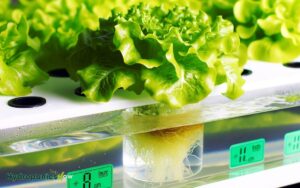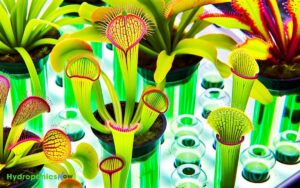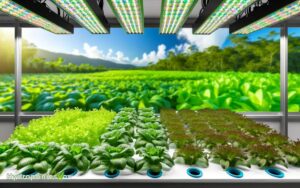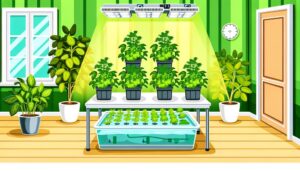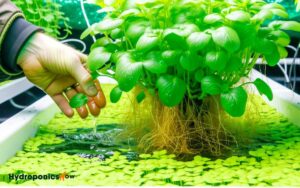Efficiently Growing Plants Hydroponically: Advantages Explored
Hydroponic farming offers several distinct advantages over traditional soil-based methods. Plants experience accelerated growth due to optimized nutrient delivery and minimized soil-borne diseases.
This method yields higher crop outputs owing to precision nutrient management and efficient mineral absorption.
Water usage is greatly reduced, often by up to 90%, making it highly efficient. Space is maximized through vertical farming and customizable plant arrangements.
Hydroponics also diminishes pest problems and allows for meticulous nutrient control, leading to sustainable year-round production with a smaller environmental footprint.
Discover how versatile system options further enhance these benefits in numerous contexts.

Key Takeaways
Faster Plant Growth
One notable advantage of hydroponic systems is the markedly accelerated rate of plant growth compared to traditional soil-based methods.
This acceleration is primarily attributed to the optimized delivery of nutrients directly to the plant roots.
In hydroponic systems, plants receive a carefully balanced nutrient solution, which guarantees that they have immediate access to essential minerals and compounds.
Additionally, the controlled environment of hydroponic setups—such as regulated temperature, humidity, and pH levels—further enhances growth efficiency.
The elimination of soil-borne diseases and pests also reduces plant stress, contributing to faster development.
Consequently, hydroponics allows for more precise control over plant health and growth parameters, leading to significantly reduced growth cycles and more robust plant development.
Higher Crop Yields
Hydroponic systems consistently produce higher crop yields due to the optimized nutrient delivery and controlled environmental conditions.
The precision in nutrient management allows plants to absorb essential minerals more efficiently, leading to robust growth and increased productivity.
Additionally, hydroponic environments minimize the risks posed by soil-borne diseases and pests, further enhancing plant health and yield potential.
The combination of these factors results in a significant boost in crop output compared to traditional soil-based agriculture.
| Factor | Hydroponic System |
|---|---|
| Nutrient Delivery | Optimized |
| Environmental Control | High |
| Disease Management | Effective |
| Water Usage | Efficient (discussed next) |
| Crop Yield | Increased |
Efficient Water Use
In addition to higher crop yields, hydroponic systems are renowned for their remarkably efficient water use. Unlike traditional soil-based cultivation, hydroponics recirculates water, minimizing waste. This method allows farmers to grow desert plants with hydroponics, providing an efficient way to cultivate vegetation in arid regions with limited water resources. By delivering nutrients directly to plant roots, hydroponic systems promote faster growth and reduce the need for pesticides. As a result, they offer a sustainable solution for food production in water-scarce environments.
This closed-loop system guarantees that plants receive the precise amount of nutrients and water required, greatly reducing the overall water consumption.
Studies indicate that hydroponic methods can use up to 90% less water compared to conventional agriculture. This efficiency is further enhanced by reduced evaporation and runoff losses.
Additionally, hydroponic systems can be designed to capture and reuse water, further conserving this essential resource.
Such water-use efficiency not only supports sustainable agriculture but also makes hydroponics an ideal solution for regions facing water scarcity.
Space Optimization
Maximizing the utility of available space, hydroponic systems allow for vertical farming and dense plant arrangements that greatly enhance production per square foot.
These systems leverage multi-tiered structures and stackable configurations, enabling growers to cultivate a higher volume of plants in limited areas.
Traditional soil-based farming is limited by horizontal space constraints, while hydroponics utilizes vertical space efficiently.
This spatial optimization is particularly advantageous in urban environments where land is scarce and expensive.
Additionally, hydroponic systems can be customized to fit various spatial configurations, from small-scale residential setups to large commercial operations.
The ability to control plant spacing and growth conditions further ensures efficient use of space, resulting in higher yields and more resource utilization.
Reduced Pest Problems
Moreover, by eliminating soil, hydroponic systems greatly reduce the risk of soil-borne pests and diseases, leading to healthier plant growth.
In traditional agriculture, soil acts as a medium that harbors various pests such as nematodes, root aphids, and soil mites.
These pests can severely damage plant roots, impair nutrient absorption, and ultimately diminish crop yields.
Hydroponics, by utilizing inert growing mediums and controlled environments, minimizes exposure to these detrimental organisms.
Moreover, hydroponic systems facilitate easier monitoring and management of pest populations through the use of integrated pest management (IPM) strategies.
This proactive approach not only enhances plant health but also reduces the reliance on chemical pesticides, contributing to a more sustainable and eco-friendly method of cultivation.
Fewer Soil-Borne Diseases
Hydroponic systems greatly reduce the incidence of soil-borne diseases, leading to healthier root systems. This reduction in disease prevalence is due to the absence of soil, which typically harbors pathogens.
Consequently, plants grown hydroponically experience fewer pest problems, further enhancing their growth and productivity.
Reduced Pest Problems
Removing soil from the growing process greatly reduces the risk of soil-borne diseases and pest infestations in hydroponic systems.
This significant advantage stems from the elimination of the primary medium in which these issues thrive.
In soil-based cultivation, pests and pathogens often find ideal conditions for proliferation. Hydroponic systems, however, offer a more controlled environment, minimizing the likelihood of such problems.
The following are key factors contributing to reduced pest issues:
- Sterile Growth Medium: Utilization of inert mediums like rock wool or clay pellets prevents pathogen buildup.
- Controlled Environment: Indoor setups allow precise control over humidity and temperature, deterring pest infestations.
- Regular Monitoring: Continuous observation facilitates early detection and management of potential threats.
- Isolation from External Factors: Limiting exposure to outdoor elements decreases the risk of pest ingress.
Healthier Root Systems
A key advantage of hydroponic systems lies in their ability to foster healthier root systems by reducing exposure to soil-borne diseases.
Traditional soil-based cultivation is susceptible to pathogens such as Fusarium, Pythium, and Rhizoctonia, which can severely compromise root health and plant productivity.
By eliminating soil as a growth medium, hydroponics mitigates these risks, thereby enhancing root integrity and overall plant vigor.
The controlled environment intrinsic to hydroponic systems guarantees ideal nutrient delivery and oxygen availability, which are critical for robust root development.
Consequently, plants cultivated hydroponically exhibit increased resistance to disease, reduced stress, and superior growth rates.
This method not only promotes plant health but also contributes to more consistent and predictable agricultural outcomes.
Better Nutrient Control
In hydroponic systems, improved nutrient control is achieved through precision nutrient delivery, leading to optimized plant growth.
This method facilitates enhanced growth rates by providing plants with precise nutrient concentrations tailored to their specific needs.
Additionally, customizable nutrient solutions allow for adjustments that can match the developmental stages and specific requirements of different plant species, ensuring peak health and productivity.
Precision Nutrient Delivery
How does precision nutrient delivery enhance the efficiency and effectiveness of hydroponic systems in providing ideal plant growth conditions?
Precision nutrient delivery guarantees that plants receive the precise nutrients they need, in ideal concentrations and at the right times.
This approach minimizes waste and maximizes plant health, leading to more efficient resource use and improved yields.
Key advantages include:
- Accurate Nutrient Management: Allows for precise control over nutrient uptake, preventing deficiencies and toxicities.
- Improved Water Efficiency: Nutrient solutions can be customized to reduce water usage, critical in areas with limited water resources.
- Consistent Growth: Uniform nutrient distribution ensures homogeneous growth rates and quality across all plants.
- Reduced Environmental Impact: Minimizes the runoff of excess nutrients into the environment, promoting sustainable agricultural practices.
Enhanced Growth Rates
Enhanced growth rates in hydroponic systems are achieved through meticulous nutrient management, which guarantees the best nutrient availability and uptake by the plants.
By directly controlling the concentration and composition of essential nutrients in the solution, hydroponic systems facilitate ideal nutrient absorption.
This precision minimizes nutrient deficiencies and toxicities, thereby promoting more consistent and accelerated plant growth.
Additionally, the absence of soil reduces the risk of diseases and pests that can impede growth. The optimized root environment, characterized by adequate oxygenation and consistent moisture levels, further enhances metabolic activities and photosynthesis.
Consequently, plants in hydroponic systems can experience growth rates up to 25-30% faster compared to traditional soil-based cultivation, making it a highly efficient method for agricultural production.
Customizable Nutrient Solutions
Precise nutrient control in hydroponic systems allows for the customization of nutrient solutions tailored to the specific needs of different plant species and growth stages.
This capability offers several significant advantages:
- Optimized Nutrient Uptake: By adjusting nutrient concentrations, plants receive the exact nutrients they require, enhancing growth and health.
- Reduced Waste: Customizing nutrient solutions minimizes excess fertilizer use, leading to more sustainable practices.
- Improved Yield Quality: Tailored nutrient solutions can enhance specific qualities in crops, such as flavor, color, and nutritional content.
- Adaptability: Nutrient solutions can be quickly modified to respond to environmental changes or plant stressors, ensuring consistent plant performance.
Such precise control over nutrient delivery underscores the efficiency and effectiveness of hydroponic cultivation methods.
Year-Round Production
Moreover, year-round production in hydroponics systems provides a consistent and controlled environment for plant growth, independent of external seasonal variations.
This continuous cultivation is achieved through the regulation of temperature, humidity, light, and nutrient delivery, optimizing conditions for plant development.
By eliminating the dependency on natural weather patterns, hydroponics mitigates the risks associated with climatic unpredictability, ensuring uninterrupted crop cycles.
This system not only enhances productivity but also allows for precise scheduling and forecasting of yields.
Additionally, the controlled environment reduces the incidence of pests and diseases, which are typically influenced by seasonal changes.
Consequently, hydroponics offers a reliable and sustainable method for producing high-quality crops throughout the year, meeting market demands consistently and efficiently.
Less Environmental Impact
Utilizing hydroponic systems greatly reduces environmental impact by minimizing water usage and eliminating the need for soil, which curtails soil erosion and degradation.
Hydroponic methods offer several significant environmental benefits:
Water Efficiency: Hydroponic systems use up to 90% less water compared to traditional soil-based agriculture due to recirculation and precision in water delivery.
No Soil Requirement: By eliminating soil use, hydroponics prevents issues associated with soil depletion and contamination.
Reduced Chemical Runoff: Controlled nutrient delivery systems diminish the need for pesticides and fertilizers, lowering the risk of waterway pollution.
Space Efficiency: Vertical and compact system designs enable higher yields per square foot, decreasing the overall land footprint required for cultivation.
These advantages collectively contribute to a more sustainable agricultural practice.
Versatile System Options
Building on the environmental benefits, hydroponic systems offer a multitude of versatile options tailored to different growing needs and space constraints.
These systems include nutrient film technique (NFT), deep water culture (DWC), aeroponics, and drip systems, each providing specific advantages.
For instance, NFT is ideal for small plants and efficient water usage, while DWC supports rapid growth through constant nutrient exposure.
Aeroponics maximizes oxygen delivery to roots, promoting faster growth, and is suitable for high-value crops. Drip systems, adaptable to various scales, guarantee precise nutrient delivery.
This diversity allows customization based on plant type, available space, and desired outcomes, making hydroponics a flexible solution for both commercial and hobbyist growers.
Frequently Asked Questions
What Types of Plants Are Best Suited for Hydroponic Systems?
Plants best suited for hydroponic systems include leafy greens such as lettuce and spinach, herbs like basil and mint, and fruiting plants such as tomatoes and strawberries, due to their adaptability to controlled nutrient and water conditions.
How Much Initial Investment Is Required to Set up a Hydroponic System?
Starting a hydroponic project is similar to building a well-oiled machine; initial investment usually varies from $100 to $5,000, depending on system complexity, scale, and technology integration, ensuring ideal plant growth and resource efficiency.
Can I Use Household Items to Create a DIY Hydroponic Setup?
Yes, household items can be repurposed to create a DIY hydroponic setup. Common materials include plastic containers, PVC pipes, and aquarium pumps. This approach can be cost-effective while still providing the necessary environment for plant growth.
How Do Hydroponic Crops Compare in Taste to Soil-Grown Crops?
Imagine biting into a crisp, vibrant lettuce leaf. Hydroponic crops often exhibit comparable or enhanced flavors to soil-grown counterparts, owing to precise nutrient management and controlled growth environments, ensuring consistently high-quality produce.
What Are the Common Challenges Faced in Hydroponic Gardening?
Common challenges in hydroponic gardening include maintaining ideal nutrient balance, preventing root diseases, managing waterborne pathogens, ensuring sufficient oxygenation of the root zone, and controlling environmental variables such as light, temperature, and humidity.
Conclusion
In the field of agriculture, hydroponic systems stand as a beacon of innovation, symbolizing the seamless fusion of technology and nature.
These systems offer accelerated growth, enhanced yields, and efficient resource utilization, embodying the future of sustainable farming.
By optimizing spatial use and mitigating pest issues, hydroponic cultivation presents a paradigm shift towards controlled, year-round production.
Consequently, it reduces environmental impact, heralding a new era of versatile and efficient agricultural practices.

